News
Don’t let that mossie get you
Try and avoid getting bitten by mosquitoes – this is the urgent emergency measure that a dengue expert is advocating to the public to bring down the numbers affected by this disease.
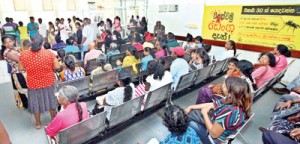
The overcrowded OPD of the Negombo Hospital. Pix by Indika Handuwala
Take immediate steps to prevent mosquito bites, urges Consultant Paediatrician Dr. LakKumar Fernando who was instrumental in setting up the Dengue Unit at the Negombo Hospital. This is while other preventive measures such as elimination of breeding areas to kill off the eggs and larvae and fumigation and eradication of adult mosquitoes kick in to place to bring about a ‘source reduction’.
Make a promise to yourself that “I will not allow myself or my child to be bitten by mosquitoes” and there will be an immediate reduction in numbers, says Dr. Fernando, detailing small precautions that will go a long way:
- Wear protective clothing such as long-sleeved shirts or tops and trousers
- Use a mosquito-repellent
- Be conscious of the time-segments when the dengue mosquitoes, Aedes aegypti and Aedes albopictus, are most active – from around 6 a.m. to 8 a.m. and from about 4 p.m. to 6.30 p.m.
- Through years of experience in handling dengue, Dr. Fernando says that it may be easier to fumigate the interiors of homes to kill off the resting mosquitoes rather than outside in the garden when they may be hiding under leaves which could give them protection.
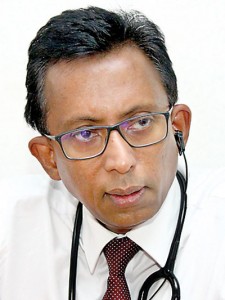
Dr. LakKumar Fernando
His suggestion about wearing protective clothing comes from the experiences in 2011 in the Pakistani epidemic. There had been a major difference in the ratio of males to females being affected by dengue. There was no rationale for the higher number of men falling victim, except that women were fully covered and thus not providing chances for the mosquitoes to take a bite to spread the virus.
Before giving an overview of the current dengue crisis, Dr. Fernando tells the Sunday Times how on Wednesday early morning all political parties and religious leaders of Negombo, the town which has the highest incidence of dengue in the whole country, gathered at the Dalupotha Church, rising above petty differences, to muster all forces and launch an all-out war on dengue. The campaign was launched with house-to-house visits for fumigation and checking and elimination of breeding spots.
The two-week clean-up programme in the Western Province, meanwhile, ended yesterday, the Dengue Control Unit’s Consultant Community Physician Dr. Preshila Samaraweera said, adding that 5,000 teams consisting the Tri-Forces, Police and health, local government and Divisional Secretariat officials took part in fogging and the collection of non-degradable items such as containers which are potential breeding places. More than 185,000 premises were inspected, 7,500 notices issued and legal action is to be taken against 1,627 people.
Paying tribute not only to his colleagues but also junior doctors, nurses and minor staff, Dr. LakKumar Fernando added that on any given day the Negombo Hospital is handling very high numbers – 700 patients. There are 250 dengue patients in the male medical ward, another 250 in the female medical ward, 200 in the paediatric ward and 17 of the “very bad” cases in the Dengue Unit. (See box)
The Sunday Times sees first-hand the large number of patients in the Outpatients Department (OPD) at the Negombo Hospital and ‘triaging’ being performed close by at the Thammita Church, where with the help of the army blood tests are being done, the results issued in about 15 minutes and a doctor screens people to determine whether they need admission or could be sent home with advice and strict instructions when to come back for re-assessment.
The number of people hit by dengue across the country, according to Dr. Fernando, could well be more than 100,000, as some may be taking blood tests and awaiting a change in their condition at home, some may be seeking treatment from General Practitioners or private hospitals and even in government hospitals, bursting at the seams with patients, notification of numbers will not be a priority as opposed to treating patients. As such, the official figure of 80,000 may be due to under-reporting.
The Herculean effort made to save lives at the Negombo Hospital under trying conditions is reflected in a number of hospitals across the country. It is these good clinical management efforts in the health sector that have made it possible to keep the death toll down to about 240.
With the Colombo district being the worst affected by dengue, the National Institute of Infectious Diseases (Infectious Diseases Hospital) in Angoda has seen more than 4,000 patients being admitted here last month, with a similar trend this month as well.
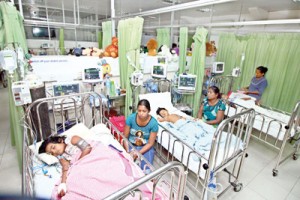
The Dengue Unit of the Negombo Hospital
Its Senior Consultant Physician Dr. Ananda Wijewickrama told the Sunday Times that the hospital has added 30 more beds, but they are still grappling with inadequate space. A request has been made to the Health Ministry and a temporary ward is to be constructed. This is while a Special Dengue Unit is already under construction, which will take at least two months to complete.
The hospital has been assigned temporary Medical Laboratory Technicians (MLTs) who perform blood tests etc., by the Health Ministry and are working 24 hours, while the triage system is also functioning, preventing unnecessary admissions.
The Colombo South Teaching Hospital in Kalubowila has had 1,500 dengue patients in June and as of this week another 400. Its Director, Dr. Asela Gunawardena, said that the maximum bed capacity in a ward, including those along corridors, is 45 and they are unable to add more beds. With a heavy flood of patients, this has resulted in two to three patients being on one bed. A High Dependency Unit (HDU) is under construction and is to be completed in two weeks.
When asked whether they have adequate numbers of MLTs, he said that the hospital has only two permanent recruits but has received four temporary MLTs from the Health Ministry. There is a problem as the OPD laboratory works only till 3 p.m. and tests thereafter have to be sent to the main laboratory, with results being issued only a hour or two later.
This has affected triaging after 3 p.m., said Dr. Gunawardena, adding that they require at least six MLTs to enable the functioning of the OPD laboratory overnight.
The Colombo North Teaching Hospital, Ragama, had 4,433 dengue patients in June of which 1,441 were confirmed as those with Dengue Haemorrhagic Fever. Its Director, Dr. Shelton Perera, said that new units are being built and as a temporary measure there has been re-allocation of beds in wards to give priority to dengue patients.
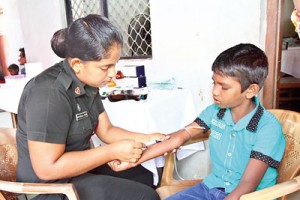
Support from the army in Negombo’s Thammita Church which doubles up as a triaging area
While the Ragama Hospital has implemented the triaging system this week, the hospital has received eight MLTs from the Medical Research Institute (MRI) and they are functioning throughout the day and the night on a shift basis, he said.
The Kiribathgoda Base Hospital is also overcrowded, with 80 beds but 137 patients, while they have received 10 more beds from the NHSL. There are about 50 to 60 floor patients, a source said, adding that there are two MLTs, but need at least two more. The triaging is functioning well under specific admission guidelines. Thus they have managed to reduce the rush.
Moving away from Colombo, the Sunday Times found that at the Kurunegala Teaching Hospital in the past two to three weeks, the number of patients increased to 270 a day. However, now there seems to be a decline, said Director Dr. Chandana Kandangamuwa, explaining that 70 beds from other wards have been added as a temporary measure and the corridors converted to wards.
Pointing out that the triage system is only in place during a disaster and they have not implemented it during this dengue epidemic, he said that they have 34 MLTs, but need five more. To get the work done in the face of this shortage, the MLTs work overtime.
Asked whether foreigners have been admitted to hospital, Dr. Kandangamuwa said that about five to 10 Chinese engineers employed at construction sites have been in hospital due to dengue.
The Gampaha District General Hospital had 3,540 patients with dengue last month, in the first week of July 248 admissions and on Thursday alone 173 admission. They had used all beds in the medical wards for dengue patients except those in the Bhikku ward and 17 beds in the medical ward which were kept for other illnesses.
The triaging system is functioning efficiently, said Director Dr. Priyantha Tennakoon, however, lamenting that there was a dearth of MLTs. The Gampaha Hospital requires seven or eight MLTs. “Currently more than 3,000 investigations are being handled by one MLT and they work after their usual duty hours.”
Close to 1,500 patients have been admitted to the Kandy Teaching Hospital in the first week of July, said Director Dr. R.M.S.K. Ratnayake, with at least 50 admissions for dengue every day. The medical wards have 381 beds and they have allocated 89 extra beds, while there are about 150 floor patients. They have requested the Health Ministry for another 270 extra beds.
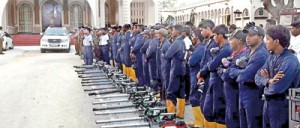
All set and armed with fumigation machines at Negombo’s Dalupotha Church to battle the dengue mosquito in a campaign launched on Wednesday
According to Dr. Ratnayake the hospital has 36 MLTs, who are working all 24 hours of the day on a shift basis. They need 19 more to fulfil the hospital’s cadre requirement, while they are also facing a dearth of other staff in the form of 224 nurses and 301 minor staff.
The triaging system has enabled the control of the rush at the hospital to some extent. However, due to the lack of space, they had to send back 30 patients from the OPD and there is a possibility of a higher rate of re-admission, he added.
The number of patients is on the rise each day and with triaging they have been able to function smoothly, said the Director of the Kegalle Hospital Dr. Wasantha Dissanayaka, pointing out that there are about 20 admissions daily. They are accommodating the excess patients in the Bhikku and orthopaedic wards. The hospital has 21 MLTs, with no dearth and four MLTs work the night shift.
Large numbers seeking treatment was the story repeated by the Kalutara General Hospital Director Dr. Pradeep Wijesinghe, according to whom on Thursday alone there were 62 dengue patients in the ward. Approval has been obtained to construct an HDU and currently the hospital is using beds in other wards to accommodate dengue patients.
There seems to be a gradual reduction in the number of dengue patients seeking treatment at the Kalmunai North Hospital due to there being two other base hospitals within 3kms, a source said, adding that the triage system is in place and the MLTs are working efficiently.
Meanwhile, private hospitals too are facing challenging times with the dengue epidemic. The Group Director for Clinical Excellence of Hemas Hospital, Dr. P.A. Gooneratne, told the Sunday Times that 177 dengue patients were admitted last month and up to Friday of this month there were 32.
Private hospitals, unlike state hospitals, do not have the capacity to provide additional beds as the set-up is organized in rooms, he said, adding that small adjustments have been made such as putting in an extra bed to a room if two patients from the same family need admission. About 50 to 60% are ‘definite’ dengue patients and the MLTs work all 24 hours.
Among the patients have been three foreigners, admitted to the Hemas Hospital in Galle, he added.
The Nawaloka Hospital, meanwhile, has even converted its auditorium, office area and lecture halls into wards, said Medical Superintendent Dr. Uthpala Malawalarachchi, adding that more than 100 beds have been allocated and extra staff and machines are being utilised. About 700 dengue patients including 50 foreigners were admitted to the hospital in Colombo in June.
| Ward 33 at NHSL solely for dengue patientsThe National Hospital of Sri Lanka (NHSL) will open a 50-bed ward dedicated to dengue patients tomorrow, to deal with the current epidemic. Ward 33 will be solely for dengue patients, NHSL Director Dr. Anil Jasinghe told the Sunday Times. In the last month (June) the NHSL had 2,388 dengue patients. | |
Saved from death against all oddsAmidst the fear of death and disease brought on by this virulent dengue epidemic, many men, women and children have been pulled from the brink of death by dedicated health staff in hospitals across the country. 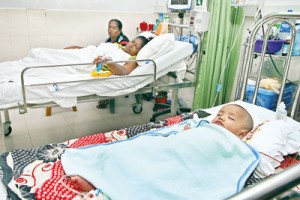 Baby Huzaifi and Head Nurse Lalitha Ranjanie on beds adjacent to each other Consultant and junior doctors, senior and junior nurses and minor staff have dedicated their time and energy, without thinking of how tired or overstretched they are to serve their countrymen. On a bed in the Dengue Unit of the Negombo Hospital is just one such case of being saved against all odds. Tiny seven-month-old Huzaifi is in deep sleep, sometimes a smile curling around his tiny lips, while his mother is at his bedside. 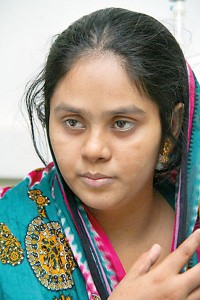 Huzaifi’s mother Rushed to a private hospital in the area from Periyamulla when he got fits due to high fever, it was on Monday that there had been a frantic call to the Negombo Hospital to send someone to save this baby’s life. The Consultant Paediatrician Dr. Wijesinghe had rushed there only to find that the little one was inert – there was no pulse, he was not breathing and almost dead. Labouring to get intravenous access, they had intubated Huzaifi who had bi-lateral pleural effusions and rushed him to the Dengue Unit while hand-ventilating him. Putting him on the bed next to the one occupied by the unit’s Head Nurse W.A. Lalitha Ranjanie who has also been struck down by Dengue Haemorrhagic Fever, the staff recall how she attempted to get off her sick bed — with platelets down to 45,000, the saline drip on and fluid leakage occurring within her body — to help put in a cannula for Huzaifi. It is a similar tale with a 17-year-old brought in with “massive bleeding” from three gastric ulcers, a haematocrit count of 63% and prolonged shock and how the state system works and responds with essential drugs, all free of charge, to save lives.He had been given three vials of Factor 7 which cost close to a million rupees and eight pints of blood, it is learnt. Each and every day, life-and-death battles waged and men, women and children pulled out from the very jaws of death not only at Negombo but across Sri Lanka. 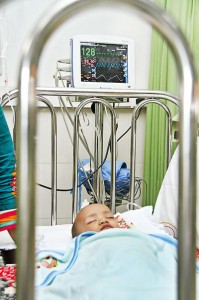 Baby Huzaifi: In slumberland, on the way to full recovery after a close brush with death | |

